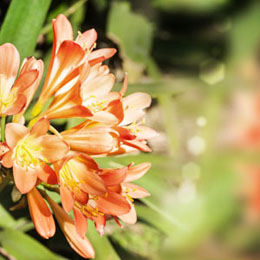How beautiful the blooms will be, depends a lot upon how well your clivia seeds have been harvested, stored, and germinated. Learn the basics with this article.

The seed is a bearer of life, for all life. Hence, its nurturing is imperative. For most plants, no matter what their size, life begins in at an embryonic stage. And a clivia plant is no different. Hence, its seed is very important to the plant's survival. Besides that, planting seeds from your own harvest is a joy every home gardener should experience.
The beautiful clivia flowers with bright sunlit colors can light up even the dullest corners. This bright orange-colored flower is a genus of monocot flowering plants from the family
Amaryllidaceae, which is native to Southern Africa. Presently six species are available along with a few hybrids that offer most shades and hues from the orange palette as well as some deep red-orange to pale yellow ones. Clivia seeds are borne in seed pods and must be removed from it at the right time, so that they won't germinate, or will germinate into week seedlings.
Harvesting
These seeds take longer than other flowering plant's seeds to develop and seed. Once the flower has been pollinated, it falls off, exposing a swollen round berry-shaped ovary. The seeds are developed within this ovary also known as pods (one flower bears one pod). The pod changes its color from green to yellow, red, or orange, and takes approximately 9 to 10 months to mature into a plant. Each pod contains no more than 4 - 5 seeds. Hence, harvesting clivia seeds properly is crucial. Once the pod has changed its color (it usually turns soft), pick it very gently. Cut it open carefully. The seeds are all held together within a soft pulp, which is held by loose fitting membranes. Remove the pulp and separate the seeds from it. Wash the seeds under running water, preferably one that is mixed with a germicidal solution. Experts recommend storing these seeds in sealed plastic bags with a few drops of water added to retain its viability. Left at room temperature, the seeds will shrink or germinate dry, but eventually die. Never freeze them, and do not store for more than two months. It is best to sow them fresh.
Germinating
For seeds to germinate successfully, they must be washed well. A few conditions that should be maintained are optimum temperature between 73° F and 77° F, high humidity, and sterile conditions that determine the seed germination success rate. Take damp compost with some perlite or vermiculite added to it. Put in a sealed plastic bag along with a few seeds, pressed slightly. The seed should be placed upwards. Place the bag near a warm dark place. The moisture in the plastic will facilitate seed sprouting which will occur in a couple of weeks. Move the seeds to a seed tray. One can place seeds in a pot with drainage holes and cover it with a plastic sheet. Once the seeds sprout, remove the cover and move the pot to diffused lighted area. Once the seeds have sprouted, like its first real leaf, transplant the germinated clivia seedling into its intended location.
Once the seeds have been planted, it is just a matter of time they will sprout plenty of new leaves. The clivia plant will bear flowers only after 2 - 4 years after planting.






 The seed is a bearer of life, for all life. Hence, its nurturing is imperative. For most plants, no matter what their size, life begins in at an embryonic stage. And a clivia plant is no different. Hence, its seed is very important to the plant's survival. Besides that, planting seeds from your own harvest is a joy every home gardener should experience.
The seed is a bearer of life, for all life. Hence, its nurturing is imperative. For most plants, no matter what their size, life begins in at an embryonic stage. And a clivia plant is no different. Hence, its seed is very important to the plant's survival. Besides that, planting seeds from your own harvest is a joy every home gardener should experience.